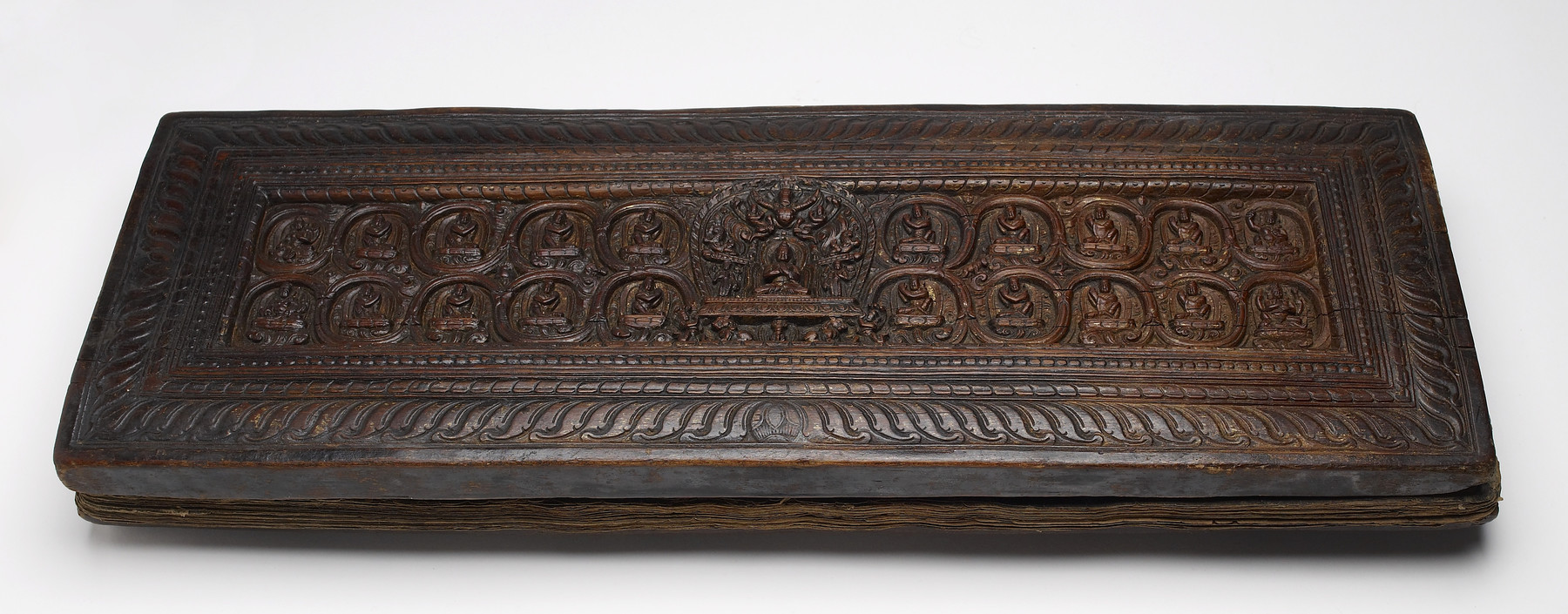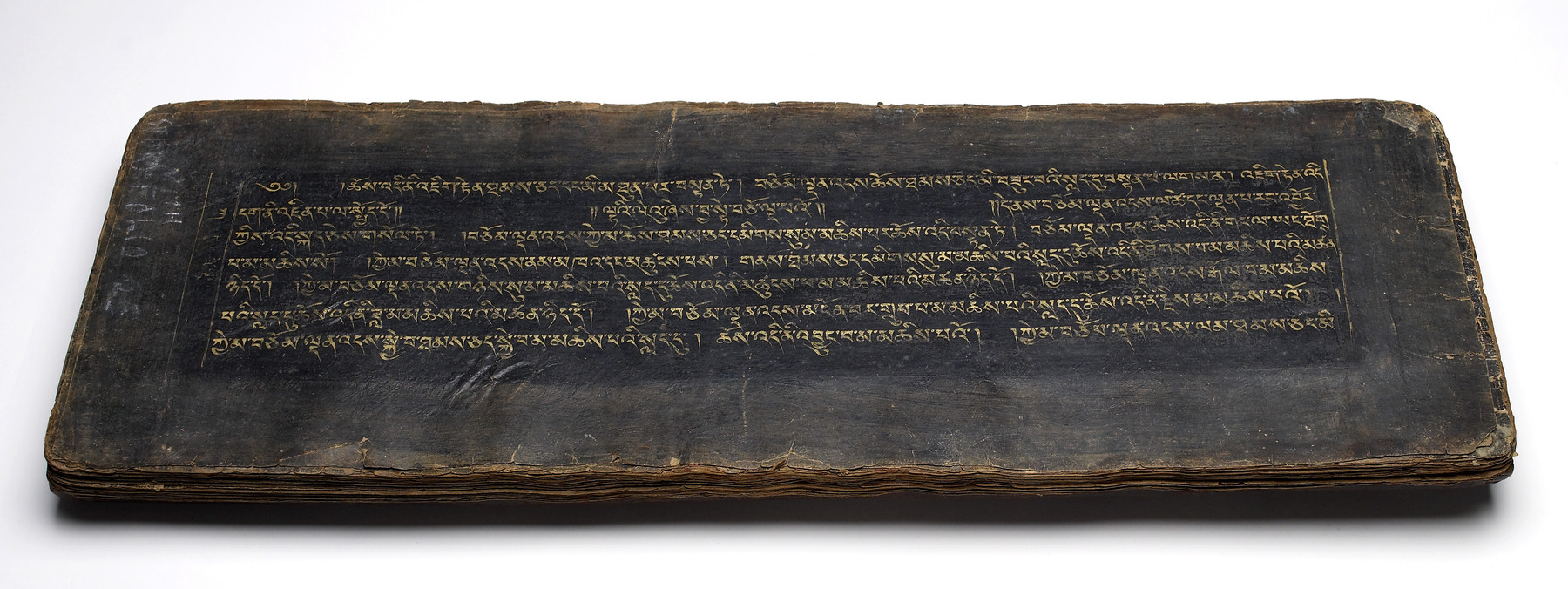Prajnaparamita Manuscript
(India, Nepal, and Tibet, Manuscripts and Rare Books)
This manuscript, consisting of loose paper folios in a horizontal format derived from palm leaves, contains the Buddhist text "Ashtasahasrika Prajnaparamita," the "Perfection of Wisdom in Eight Thousand Lines." Regarded as embodiments of the perfect wisdom that leads to Buddhahood, texts of the "Prajnaparamita" genre are not only read but also worshiped. The richly dyed blue paper and gold ink of this manuscript attest to its status as an object of reverence, for its patron spared no expense on its production. Indeed, an inscription on the final folio (WAM W.856.2) refers to the manuscript as a sacred object and informs the reader that it was commissioned for the benefit of the next rebirth of the patron’s parents. Originally a Sanskrit text written in India around the turn of the Common Era, the "Ashtasahasrika Prajnaparamita" circulated widely throughout the Buddhist world and was translated into many languages; this manuscript is in Tibetan.
Enclosing the folios are two wooden boards bearing Buddhist imagery carved in relief. The lower board is mostly plain, but displays seven Buddha images on one of its short ends. The upper board is more elaborate, its broad top covered in imagery featuring a central Buddha flanked by twenty figures framed by the tendrils of curling vines, along with additional figures. The central Buddha sits enthroned on a lotus supported by two serpents and two lions; a "vajra" symbol at the lower center marks the object’s affiliation with tantric Buddhist ("Vajrayana") patronage. Holding his hands in a gesture of teaching, this Buddha is immediately flanked by the goddesses Tara (proper right) and Prajnaparamita (proper left; the personification of the text, she is identified by the manuscript that rests on the lotus she holds). A protective "garuda" bird spreads his wings over the Buddha, and branches extending from the upper sides of the aureole recall the "bodhi" tree under which Shakyamuni Buddha attained enlightenment. Stemming from either side of the central aureole are two rows of vines, their curving stems framing figures that turn toward the central Buddha in reverence. They include lay worshipers wearing jewelry, monks in simple robes, and additional Buddhas marked by the cranial protuberance that only a Buddha has. The four figures on the ends of the manuscript cover are deities; they face frontally rather than turning toward the center. On the viewer’s left (or to the proper right of the central Buddha) are the goddess Tara above and the wealth god Jambhala below. On the viewer’s right (proper left) are two wrathful deities, who offer protection to the teachings the manuscript contains. Tiny animals sit in the space between the six pairs of tendrils closest to the center: from left to right are a peacock, deer, monkey, and goose. Traces of gold suggest that the cover was once completely gilded, its radiance and luster heralding the brilliance of the text within.
Provenance
Provenance (from the French provenir, 'to come from/forth') is the chronology of the ownership, custody, or location of a historical object. Learn more about provenance at the Walters.
Ian Alsop, New York and Santa Fe; purchased by John and Berthe Ford, Baltimore, 1998; given to Walters Art Museum, 2016.
Exhibitions
| 2001-2003 | Desire and Devotion: Art from India, Nepal, and Tibet in the John and Berthe Ford Collection. The Walters Art Museum, Baltimore; Santa Barbara Museum of Art, Santa Barbara; Albuquerque Museum, Albuquerque; Birmingham Museum of Art, Birmingham; Hong Kong Museum of Art, Hong Kong. |
Geographies
Tibet (Place of Origin)
Measurements
H of upper board: 9 1/8 × W: 26 1/2 × D: 1 7/16 in. (23.2 × 67.3 × 3.6 cm); H of lower board: 8 7/8 × W: 27 3/8 × D: 1 1/4 in. (22.5 × 69.6 × 3.2 cm); H of larger textblock: 9 1/4 × W: 27 1/8 × D: 3 1/4 in. (23.5 × 68.9 × 8.2 cm); H of smaller textblock: 9 3/16 × W: 27 1/4 × D: 13/16 in. (23.4 × 69.2 × 2 cm)
Credit Line
Gift of John and Berthe Ford, 2016
Location in Museum
Not on view
Accession Number
In libraries, galleries, museums, and archives, an accession number is a unique identifier assigned to each object in the collection.
In libraries, galleries, museums, and archives, an accession number is a unique identifier assigned to each object in the collection.
W.856
Do you have additional information?
Related Objects






